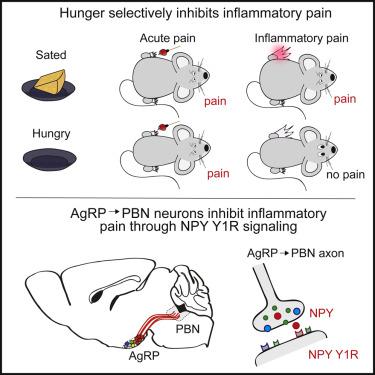Our official English website, www.x-mol.net, welcomes your feedback! (Note: you will need to create a separate account there.)
A Neural Circuit for the Suppression of Pain by a Competing Need State.
Cell ( IF 64.5 ) Pub Date : 2018-Mar-22 , DOI: 10.1016/j.cell.2018.02.057 Amber L Alhadeff 1 , Zhenwei Su 1 , Elen Hernandez 1 , Michelle L Klima 1 , Sophie Z Phillips 1 , Ruby A Holland 2 , Caiying Guo 3 , Adam W Hantman 3 , Bart C De Jonghe 2 , J Nicholas Betley 1
Cell ( IF 64.5 ) Pub Date : 2018-Mar-22 , DOI: 10.1016/j.cell.2018.02.057 Amber L Alhadeff 1 , Zhenwei Su 1 , Elen Hernandez 1 , Michelle L Klima 1 , Sophie Z Phillips 1 , Ruby A Holland 2 , Caiying Guo 3 , Adam W Hantman 3 , Bart C De Jonghe 2 , J Nicholas Betley 1
Affiliation

|
Hunger and pain are two competing signals that individuals must resolve to ensure survival. However, the neural processes that prioritize conflicting survival needs are poorly understood. We discovered that hunger attenuates behavioral responses and affective properties of inflammatory pain without altering acute nociceptive responses. This effect is centrally controlled, as activity in hunger-sensitive agouti-related protein (AgRP)-expressing neurons abrogates inflammatory pain. Systematic analysis of AgRP projection subpopulations revealed that the neural processing of hunger and inflammatory pain converge in the hindbrain parabrachial nucleus (PBN). Strikingly, activity in AgRP → PBN neurons blocked the behavioral response to inflammatory pain as effectively as hunger or analgesics. The anti-nociceptive effect of hunger is mediated by neuropeptide Y (NPY) signaling in the PBN. By investigating the intersection between hunger and pain, we have identified a neural circuit that mediates competing survival needs and uncovered NPY Y1 receptor signaling in the PBN as a target for pain suppression.
中文翻译:

通过竞争性需求状态抑制疼痛的神经回路。
饥饿和痛苦是个人必须解决以确保生存的两个相互竞争的信号。但是,人们对优先考虑冲突生存需求的神经过程知之甚少。我们发现饥饿可以减轻行为反应和炎症性疼痛的情感特性,而不会改变急性伤害性反应。由于在表达饥饿敏感的刺豚鼠相关蛋白(AgRP)的神经元中消除了炎性疼痛,因此这种作用受到了中央控制。对AgRP投射亚群的系统分析显示,饥饿和炎性疼痛的神经处理收敛于后臂臂臂旁核(PBN)中。令人惊讶的是,AgRP→PBN神经元中的活性与饥饿或止痛药一样有效地阻断了对炎性疼痛的行为反应。饥饿的抗伤害感受作用是由PBN中的神经肽Y(NPY)信号介导的。通过研究饥饿与疼痛之间的交集,我们已经确定了介导竞争性生存需求的神经回路,并且在PBN中发现了NPY Y1受体信号传导作为抑制疼痛的目标。
更新日期:2018-03-22
中文翻译:

通过竞争性需求状态抑制疼痛的神经回路。
饥饿和痛苦是个人必须解决以确保生存的两个相互竞争的信号。但是,人们对优先考虑冲突生存需求的神经过程知之甚少。我们发现饥饿可以减轻行为反应和炎症性疼痛的情感特性,而不会改变急性伤害性反应。由于在表达饥饿敏感的刺豚鼠相关蛋白(AgRP)的神经元中消除了炎性疼痛,因此这种作用受到了中央控制。对AgRP投射亚群的系统分析显示,饥饿和炎性疼痛的神经处理收敛于后臂臂臂旁核(PBN)中。令人惊讶的是,AgRP→PBN神经元中的活性与饥饿或止痛药一样有效地阻断了对炎性疼痛的行为反应。饥饿的抗伤害感受作用是由PBN中的神经肽Y(NPY)信号介导的。通过研究饥饿与疼痛之间的交集,我们已经确定了介导竞争性生存需求的神经回路,并且在PBN中发现了NPY Y1受体信号传导作为抑制疼痛的目标。



























 京公网安备 11010802027423号
京公网安备 11010802027423号